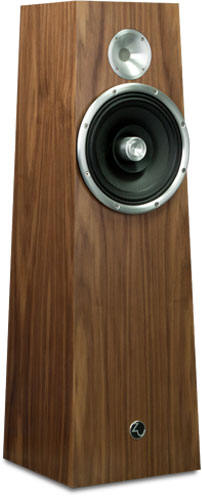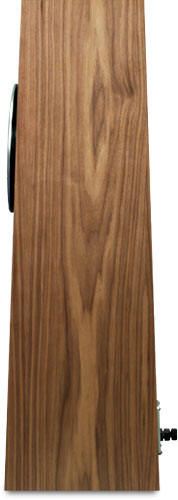|
You are reading the older HTML site
Positive Feedback ISSUE 54
The Neoteric Listener...
Zu Audio's Soul Superfly Loudspeakers
Standing on the harbor dock, taking in the wreckage of an unbroken film of dead sardines is one of those lessons in perspective that, to quote rock icon, David St. Hubbins, is "Too much, there's too much [effing] perspective now." Hammered by stormy ocean waters, a few million sardines broke one way to a safe ocean channel while another group swam to what appeared to be a tranquil harbor basin, only to use up all the oxygen and die. Was it fate, or bad decision making? Who knows? Nature doesn't care either way, but I feel sorry for all of those sardines that were just following along. Not to be cavalier about the loss—some would say I've seen a million souls migrating in a Hindu circle of reincarnation—but nothing like 140 tons of dead sea-life to remind you that some decisions really matter. Choose this way; you're back swimming in the ocean. Follow the other group; you're part of the great circle of life as bait or plant food. Walking away from the stench and calamity, and thinking that I'd rather be in the warm earth than on a hook, I reflected on the consequences of choices. I'm thankful that most of my decisions are trivial things like which bagel to eat or whether I prefer 44.1 or 48kHz on Boney M.'s "River of Bablyon." So when I see audiophiles embroiled in slap fights about which speaker is best, or about how selecting the right pair of loudspeakers is "one of the most important decisions you can make," well... Truth is, there are lots of splendid speakers out there that can provide a lifetime of entertainment, and not too many speakers so unlistenable they cause permanent discomfort and remorse. What there is an awful lot of, however, is sameness of sound that makes one speaker pretty much indistinguishable from the next. I mention this observation because sameness so inaptly describes the Zu Audio Soul Superfly loudspeakers. Incredibly dynamic, open, and responsive, these loudspeakers comprise a different type of sound from most other speaker designs. It's easy to catalog the many things these speakers do well, but you can't hear a song by reading a music score, and you can't encapsulate the Superflys by listing their qualities piecemeal. But I'll give it a shot, anyway. Thinking back to when my wife first heard the Superflys in our home, I now realize that she summed them up beautifully: "They sound so clear!" No audiophile she (thankfully), but ringing just as clear as a bell is a tough trick for any good speaker to pull off.
So what do full-range drivers, cabinet symmetry, and ball feat have to do with music? Well, quite a bit, apparently, if the Soul Superflys are any example. The most striking aspect of these speakers is the immediacy and dynamic impact of music, especially when played at higher volume levels. Daily and Vincent's ethereal bluegrass rendering of the spiritual "By the Mark" is a resplendent pitch-perfect blend of harmonies, banjo, mandolin, and dulcimer. The Superfly's engaging midrange qualities captured all of the exquisite grain of the anchoring bottom harmony, while the time-aligned tweeter not only conveyed the shimmering high harmony with appropriate intensity, but so smooth was the coherence that it provides a fine introduction to the vaunted "live" sound so often used to describe Zu speakers. These speakers are quick, dynamic, and powerful. This sense of immediacy shouldn't be attributed to an exaggerated degree of resolution; the Zus don't try to tell you whether the banjo head is calf skin or goat skin. But the combination of depth, dynamic responsiveness, and detail retrieval invites the listener to perceive the music as a performance much better than speakers that, by attempting to replicate every iota of music, only emphasize the speakers' artificiality. To illustrate, Deer Tick's "Mange" is a new-band-old-sound type of recording that hard pans drums right, runs accent guitars left, and places bass and vocals deep center so much you think you're back in the Trans Am wearing your sleeveless muscle shirt and listenin' to a little Lynryd Skynyrd. Lots of small details add up to a big impact in this song, and the steady picking of the rhythm electric guitar only works if the counter rhythm of snare, cymbals, and floor tom (recorded like they're coming from a room down the hall) are distinct but still locked together in sequence. Each tone displays an important sonic color that shouldn't be blurred and the speaker's pace and timing makes those tones dance in step. The Soul Superflys uncage this tune so that each element of the recording is sharp enough to be discerned, tonally accurate enough to be recognized, and responsive enough to be perceived as something happening right now—not as an artifact from a recording studio eighteen months earlier. Some speakers shooting for the uncolored/unfiltered medallion end up sounding so thin and unsubstantial it's like eating a bowl of ice milk. In contrast, the Superflys' focus and imaging strengths work in concert with an almost total absence of boxiness to create a very believable impression that what you hear is real. Several times, when playing internet radio and concentrating on something I else, I found myself being startled by the unexpected appearance of a Slavic voice extolling, I'm guessing, the virtues of some odd trance tune or other that had just been played. Inspired by this vocal realism, I dug out the audio books usually reserved for boring the unfortunate on long car trips, and gave them the Soul Superfly treatment. You know a speaker is transparent when you thrill to chill in your wigwam, playing recordings of Longfellow's tale of the lovely Minnehaha or Whitman's vigorous celebration of "the party of young fellows, robust, friendly/Singing with open mouths their strong melodious songs."
As noted, I don't need or like overwhelming BASS!, but a speaker should be able to kerplunk the top CD off the pile when called upon. Lately, I've been playing a lot of Mercer music (Michael, not Johnny) because my fellow PFO scribe always finds things that sound cool and help keep me out of the nostalgia jukebox. The slow, funeral pace of the The Kings of Limbs' "Codex" is underpinned by simple one hand piano chords, but even more so by the on-beat bass and kick drum time keeping. Granted, my room is small, but the trademark immediacy and focus of these Zu speakers gave the bottom frequencies plenty of burly heft and impact. Michael described Bleak's "Dundry Hill" as a "tip-of-the-hat to the Velvet Underground" but I prefer to think of it as a tip-of-the-middle-finger to anyone who likes their tunes dancey and janglely. Most of the song consists of what sounds like a bass guitar being played with a violin bow and accompanied by a chorus of godforsaken moans. In other words, just the sort of brackish Moat Music I like to frighten the postman and give solicitors fair warning. In my room, the Soul Superflys pulled this processional of menacing low notes in such a slow, mournful dirge, I had to restrain the CD player from leaping from the second shelf. Maybe not six feet deep low frequencies, but way more than enough for my room, and I suspect way more than enough for a medium sized room as well. Larger than that, I won't venture, and those who like low frequencies that detonate might have to move up to one of the larger Zu models. Where many speakers are content to accent the listening area like beautiful grace notes, the Soul Superflys take command. They are the sole (no pun intended, for a change) sonic vantage point, not by virtue of their size or fussiness in positioning, but in their riveting performance. The Soul Superflys are made for people who don't want to chalk out their living rooms like a da Vinci geometric pencil drawing just to figure out where the speakers go. The shack is small, so serious listening is near-field whether I want it to be or not. Most of the time, I wedged the Superflys into corners and let them fight it out for themselves. And they did, because there were countless times when I put on something that could muddy up at the drop of a synthesized high-hat (Wolfgang Amadeus Phoenix's hard-driving, multi-layered "Fences" for example), only to be amazed at how integrated, forceful, and lively the sound appeared. So when the accompanying guidebook insists that the speakers "are not overly sensitive to placement," that's what I experienced, too, more or less. But I had to laugh when that sentence is promptly followed by a thousand word treatise on how to fine-tune speaker placement, complete with suggested titles for further illumination on the subject. Everything I've read or discovered in my interactions with Zu is that they want to be of the people and for the people, but they just can't hide that they are (to quote the late, great James Brown) into it, man, they're doin' their thing. The Soul Superflys are, by audiophile standards, inexpensive speakers, but they still represent a fair investment. Fortunately, build quality is high (claimed to last 100 years) and their sound merits serious consideration by all listeners not only in this price category, but considerably above it as well. While the Zu website and manuals are whimsical, informative, and definitely unpretentious, the innovative Soul Superflys reflect serious design zealotry. If you prefer your speakers to be well-bred exemplars of old-school gentility, the Soul Superflys will seem like upstart suited-and-booted game changers who back their Beamers into parking spaces. For many, however, the Soul Superflys combine style, engineering, and design philosophy that offer today's listener a thoroughly appealing loudspeaker option. Take Zu's advice and avoid amps that are overly bright or grainy and these speakers will bestow impressively inviting and engaging sound. For those who like their music to move and groove, the Soul Superflys is a choice done right. Recommended.
Soul Superfly
Loudspeaker Zu Audio http://www.zuaudio.com
|


 The Superflys' inimitable sound
is, of course, the result of careful design and materials, and Zu is happy to do
a little bragging: "Full-range high output Zu10HO-16 driver, ZuRG
driver/box/room acoustic loading technology, no crossover or filters on
full-range driver, complimented by a phenolic-composite dome, time-aligned
machined from 6061 billet lensed tweeter." The 101 dBSPL@1 watt, 1 meter
efficiency is almost unbelievable (measurements available for those who scoff),
and the 16 ohm design makes the Superflys a natural partner with all tube amps.
As good luck would have it, the Cary SLI 80 reviewed in this issue is an
excellent bandmate for the Soul Superflys, and I was able to slow-play the amp's
return––and Cary's patience––until this review was finished. Doesn't mean that
you only have to use tubes (the Superflys sounded really nice with my Arcam A-80
for example) but there's no doubt that these speakers are voiced for the unique
qualities that tubes impart on the sound. The shape of the Soul Superfly reminds
me of those Mayan pyramids of Teotihuacan (minus the steps and image of a
god-like ruler in leopard loin cloth and feathered jaguar headdress). The
geometry and materials of the cabinet is said to "minimize cabinet resonances."
The driver array is described as 1-1/2 directional, the speaker footprint is
about 12'' square, and each Soul Superfly weighs 53 pounds. The Superflys
come with fairly long spikes and stainless ball footers to raise the
speakers off the floor of carpets and hardwood, respectively, which you'll
want to do because the speakers are ported from the bottom.
The Superflys' inimitable sound
is, of course, the result of careful design and materials, and Zu is happy to do
a little bragging: "Full-range high output Zu10HO-16 driver, ZuRG
driver/box/room acoustic loading technology, no crossover or filters on
full-range driver, complimented by a phenolic-composite dome, time-aligned
machined from 6061 billet lensed tweeter." The 101 dBSPL@1 watt, 1 meter
efficiency is almost unbelievable (measurements available for those who scoff),
and the 16 ohm design makes the Superflys a natural partner with all tube amps.
As good luck would have it, the Cary SLI 80 reviewed in this issue is an
excellent bandmate for the Soul Superflys, and I was able to slow-play the amp's
return––and Cary's patience––until this review was finished. Doesn't mean that
you only have to use tubes (the Superflys sounded really nice with my Arcam A-80
for example) but there's no doubt that these speakers are voiced for the unique
qualities that tubes impart on the sound. The shape of the Soul Superfly reminds
me of those Mayan pyramids of Teotihuacan (minus the steps and image of a
god-like ruler in leopard loin cloth and feathered jaguar headdress). The
geometry and materials of the cabinet is said to "minimize cabinet resonances."
The driver array is described as 1-1/2 directional, the speaker footprint is
about 12'' square, and each Soul Superfly weighs 53 pounds. The Superflys
come with fairly long spikes and stainless ball footers to raise the
speakers off the floor of carpets and hardwood, respectively, which you'll
want to do because the speakers are ported from the bottom.  Speaking of strong melodious
songs, now would be a good time to disclose the Soul Superfly's chief virtue:
they sound really good, really loud. Make that really, really good, really,
really loud. As the time for returning these loudspeakers came nearer, I
started scrambling for the meatiest beatiest biggest and bounciest
recordings I could find. Blasting Quadraphenia at blissfully "Loud, Reign o'er
Me" levels told me what I already knew: the Soul Superflys have plenty of punch
and precision for a blistering evening of rock n' rowdy. But playing Beethoven's
First Movement from Symphony No.5 in C Minor, OP.67, I was surprised to find
things getting even more out of hand. Though this might be the most clichéd
musical selection in human history, the louder I played it, the more intensely I
embraced it, and the more I embraced it, the louder... well, you get the idea.
Hendrix's "Manic Depression" at "don't-eat-the-brown-acid" levels fit these
speakers like a pair of tight striped bell-bottom trousers, not only because
they could easily keep up with the hyper-flanged guitar bouncing from speaker to
speaker, but also because of the excellent representation of Noel Redding's bass
guitar. Although I have heard some wonder if the bottom-firing bass port can
adequately deliver the low frequencies, the Soul Superflys can shake a
[moderate-sized] room from the cellar.
Speaking of strong melodious
songs, now would be a good time to disclose the Soul Superfly's chief virtue:
they sound really good, really loud. Make that really, really good, really,
really loud. As the time for returning these loudspeakers came nearer, I
started scrambling for the meatiest beatiest biggest and bounciest
recordings I could find. Blasting Quadraphenia at blissfully "Loud, Reign o'er
Me" levels told me what I already knew: the Soul Superflys have plenty of punch
and precision for a blistering evening of rock n' rowdy. But playing Beethoven's
First Movement from Symphony No.5 in C Minor, OP.67, I was surprised to find
things getting even more out of hand. Though this might be the most clichéd
musical selection in human history, the louder I played it, the more intensely I
embraced it, and the more I embraced it, the louder... well, you get the idea.
Hendrix's "Manic Depression" at "don't-eat-the-brown-acid" levels fit these
speakers like a pair of tight striped bell-bottom trousers, not only because
they could easily keep up with the hyper-flanged guitar bouncing from speaker to
speaker, but also because of the excellent representation of Noel Redding's bass
guitar. Although I have heard some wonder if the bottom-firing bass port can
adequately deliver the low frequencies, the Soul Superflys can shake a
[moderate-sized] room from the cellar.